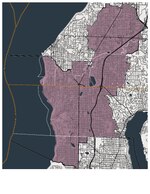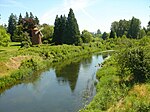Lake Forest Park, Washington
1912 establishments in Washington (state)Cities in King County, WashingtonCities in Washington (state)Cities in the Seattle metropolitan areaPlanned cities in the United States ... and 2 more
Populated places established in 1912Use mdy dates from April 2020

Lake Forest Park is a suburban city in King County, Washington, United States, located northeast of Seattle. It was developed in the 20th century as a bedroom community with single-family housing on medium to large-sized lots. Less than 4% of the city's land is zoned commercial, largely concentrated in one location, and there are no industrial areas. The city is situated at the northwest end of Lake Washington along State Route 522, which provides connections to Seattle and Bothell. Lake Forest Park includes several parks and nature reserves, access to the Burke–Gilman Trail, and organized summer events. The population of the city was 12,598 at the 2010 census.
Excerpt from the Wikipedia article Lake Forest Park, Washington (License: CC BY-SA 3.0, Authors, Images).Lake Forest Park, Washington
Northeast 180th Street,
Geographical coordinates (GPS) Address Nearby Places Show on map
Geographical coordinates (GPS)
| Latitude | Longitude |
|---|---|
| N 47.756666666667 ° | E -122.28972222222 ° |
Address
Northeast 180th Street 3613
98155
Washington, United States
Open on Google Maps









